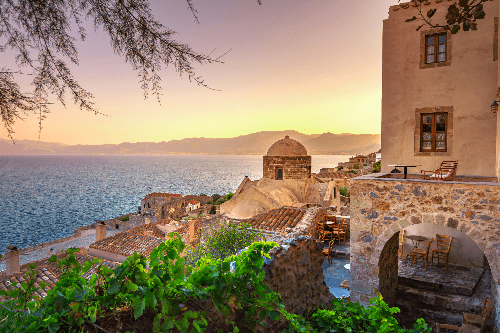Where is the Peloponnese Region of Greece?
The Peloponnese region is a peninsula connected to the central part of Greece by the Isthmus of Corinth. This isthmus is where the Corinth Canal was built in 1893, and what separates the Gulf of Corinth from the Saronic Gulf.
This large peninsula holds three (3) regions of Greece: the Peloponnese region, the Western region, the Attica region.
The Peloponnese Region is the biggest region of the three, and is the southernmost part of mainland Greece. If you’re travelling west from Athens, you can reach it in just an hour.
The Peloponnese Region is divided into five (5) areas:
– Corinthia
– Argolis
– Arcadia
– Laconia
– Messenia
What does the Peloponnese Region of Greece have to offer?
There is one (1) airport:
– Kalamata International Airport
And four (4) ports:
– Neapolis
– Gythio
– Ermioni
– Porto Heli
Agriculture
Agricultural products in the Peloponnese region include figs, olives, olive oil, rice, cotton, tobacco, vegetables, legumes, sheep, honey, cheese, and dairy products. There are also many beautiful wineries and vineyards worth visiting.
Beaches of the Peloponnese Region
There are many beautiful and popular beaches, such as Simos Beach (on Elafonisos Island), Panagia Beach (on Elafonisos Island), Mavrovouni Beach, Voidokilia Beach, Megali Paralia, Tolo Beach, Romanos Beach, Finikounda Beach, Kalamata Beach, Golden Beach (Divari Beach), Peroulia Beach, Plytras Beach, and Karathona Beach.
Restaurants
There are many excellent restaurants and places to eat, especially in popular areas such as Kalamata, Nafplio, Monemvasia, Loutraki, Corinth, Tripoli, and Porto Heli.
Tourism
Corinth Canal
The Corinth Canal is what separates the Peloponnese region from the mainland, or Attica region. The canal was cut through the narrow Isthmus of Corinth and is 4 miles long (6.4 kilometers) and 70 feet wide (21.4 meters). It was completed in 1893, and is now a major tourist attraction.
Nafplio
Nafplio was once the capital of Greece, and is a beautiful seaside town. Nafplio has an architectural style that shows Venetian influence, since it was dominated by them from 1338 to 1540.
Only two hours from Athens, Nafplio houses an Archaeological Museum in a lovely Venetian building. While in Nafplio, many visitors also visit the theatre in Epidaurus (a Unesco World Heritage Site). Located 30 kilometers east of the city, Epidaurus was built in the 4th century BC., and was used to host entertainment for the sick coming for miracles.
Kalamata
This coastal town has beautiful architecture, beaches, and thousands of acres of olives. Yes, this is Kalamata, the place of the famous Kalamata olives. Olive tours are offered so visitors can learn about the entire process of how these olives are planted and harvested.
Kalamata has some of the most delicious produce in the world due to its climate, and visiting the city’s central market is one of the best ways to sample some of the local delicacies.
Significant Archaeological Sites in the Peloponnese Region
Temple of Apollo Epicurius at Bassae
The columned temple of Apollo Epicurius is one of the most well preserved monuments in Greek architecture. Built in the 5th century and dedicated to Apollo, it has 15 columns lengthwise and six (6) columns on the facade. This is Greece’s first UNESCO World Heritage Site.
Monemvasia
Monemvasia is the site of an amazing medieval fortress. In fact, the Old Town and the Castle of Monemvasia have been built into the slopes of a huge rock that rises from the sea. The town walls and many Byzantine churches remain from the medieval period.
Pavlopetri
Pavlopetri is one of the oldest underwater cities in the world, and the oldest in the Mediterranean Sea. Dating back to the early Bronze Age (3500 BC), Pavlopetri is part of the underwater cultural heritage as defined by the UNESCO.
Diros Caves
The Diros caves were once believed to be the entrance to the underworld. Dating back to 4000-3000 BC, the caves were also a place of worship in Neolithic and Paleolithic times. There are 2,800 waterways snaking 15 kilometers into the rock. Boat tours are now available to explore 1.5 kilometers of the biggest cave and to see some of the incredible stalactites and stalagmites.
~~~~~~~~~~~~~~~~~~~~~~~~~~~~~~~~~~~~~~~~~~~~~~~~~~~~~~~~~~~~~~~~~~~~~~~~~~~
See some of our Peloponnese region recipes here.
Do you have a special recipe from this region that you love? Share it with us!

